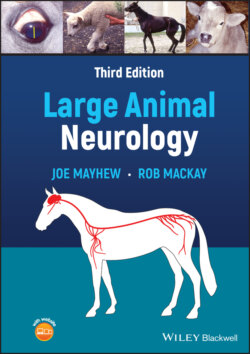Читать книгу Large Animal Neurology - Joe Mayhew - Страница 35
Sympathetic innervation to the eyes and head
ОглавлениеAlthough not classical cranial nerves, these neuronal fibers are involved in pupillary function and can be conveniently considered here. Nuclei within the brain that control sympathetic motor function are in the hypothalamus, midbrain, pons, and medulla oblongata. First‐order neuronal fibers descend through the midbrain, medulla, and cervical spinal cord to synapse on cell bodies in the lateral intermediate gray columns in the thoracolumbar spinal cord. The preganglionic, second‐order, sympathetic cell bodies supplying the head and neck are situated in this position in the cranial thoracic segments, T1–T3. Axons leave these segments of the spinal cord, traverse the cranial thorax,19 ascend the neck in the cervical sympathetic trunk adjacent to the vagus nerve, and pass to the cranial cervical ganglion that lies under the cranial part of the atlas. In the horse, this ganglion is on the caudodorsal wall of the medial compartment of the guttural pouch. Postganglionic, third‐order, sympathetic fibers leave the cranial cervical ganglion to innervate the glands, smooth muscles and blood vessels of the eyeball, and the head and cranial cervical area at the level of C1 and C2 (Figure 2.10). Sympathetic fibers supplying the skin of the neck from C2–C8 leave the parent bundles in the thorax and pass cranially as the vertebral nerve with the vertebral vessels all running within the lateral vertebral foramina to join the segmental vertebral nerves supplying each cervical dermatome.
Damage to the sympathetic supply to the eye and its associated structures results in slight ptosis of the upper lid, a miosis or constriction of the pupil, slight enophthalmos, and a slight protrusion of the nictitating membrane. Vision and the pupillary light responses are unaffected. In most species, this is referred to as the Horner syndrome. Prominent in horses is a resulting change in eyelash angle that occurs due to loss of innervation of eyelid muscles under sympathetic control, especially the m. arectores cilliorum, all of which help maintain a relatively horizontal eyelash angle.
In the horse at least, lesions involving the sympathetic supply to the head result in these ophthalmic signs, as well as additional signs consisting of dilation of facial blood vessels, hyperemia of nasal and conjunctival mucous membranes, and increased temperature and sweating of the face. Sweating is most prominent at the base of the ear—due to a high sweat gland population there—and can extend a variable distance down the neck dependent upon the exact lesion site. Ptosis is the eye sign most consistently observed in large animals, and this may be the only sign with retrobulbar sympathetic involvement but usually accompanied by periorbital sweating in horses. However, with more proximal lesions of the sympathetic supply to the head in horses, there is usually prominent sweating and vasodilation of the sympathetically denervated skin.20, 21 Lesions in the region of the guttural pouch and cranial cervical ganglion will result in sweating of the face and the cranial neck down to the level of C2.22 Most likely the postganglionic fibers follow branches of the trigeminal nerve, thus some lesions of these branches have resulted in localized sweating of the rostral face only with infraorbital involvement of the maxillary branches in the absence of signs of eye involvement. Lesions further down the neck involving the sympathetic trunk may result in sweating of the face and the neck extending down to the level of C3. Lesions in the thoracic inlet can result in this sweating extending down to the level of the shoulder with involvement of other thoracic sympathetic nerves in addition to the cranial cervical sympathetic trunk. Selective lesions in the neck involving segmental branches from the paravertebral nerve that passes up the vertebral lateral foramina can result in linear saddles of sweating over the neck between C3 and C8 dermatomal segments. Although extremely rare, lesions of the spinal cord involving the descending sympathetic pathway can result in eye involvement and sweating of the whole side of the body ipsilateral to the lesion. This is because all the sympathetic fibers leaving the spinal cord have lost their central motor neuron connections and are thus decentralized and nonfunctional.
Figure 2.10 Sympathetic pathways showing outflow from CNS to face, neck, and trunk.
The reason for sweating with cutaneous sympathetic denervation in horses is not entirely clear as equine skin probably has predominantly cholinergic, not adrenergic neural supply, and although nerve endings are close to sweat glands and their accompanying prominent small blood vessels, they may not actually innervate the glandular secretory cells.20 An explanation is that loss of sympathetic supply results in cutaneous vasodilation that brings more circulating adrenalin to the sweat glands, and this hormone has a powerful sudomotor effect in that species.
Cattle that have lost the sympathetic supply to the head show the same signs involving the eye and periorbit, dilated blood vessels over the pinna, and a lack of sweat production on the muzzle. Only eye signs have been detected with sympathetic denervation of the head and neck in sheep and goats, although this could be studied with greater diligence.
